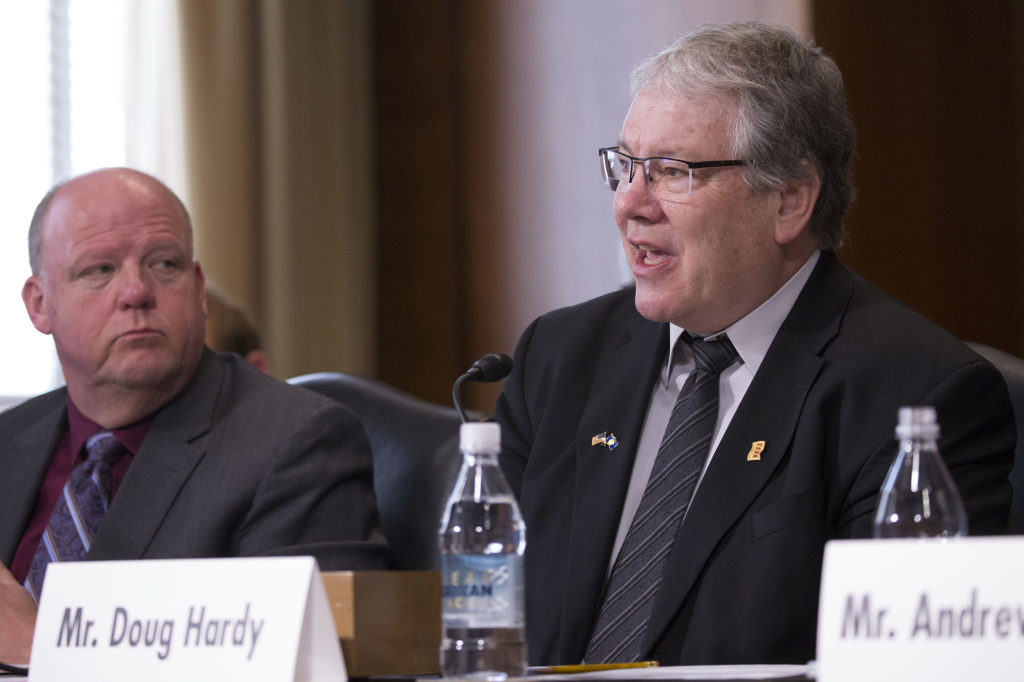
In a U.S. Senate hearing examining rural energy solutions, electric cooperative leaders highlighted how Congress can help co-ops continue reliable, affordable service to their members.
Senate Energy and Natural Resources Committee Chairman Lisa Murkowski, R-Alaska, said she recognized the importance of keeping energy costs low for families in rural America and offered witnesses the opportunity to discuss their concerns.
Doug Hardy, general manager of Central Montana Electric Power Cooperative in Great Falls, and Matt Greek, senior vice president of research, development and technology at Basin Electric Power Cooperative in Bismarck, North Dakota, testified April 19.
Central Montana Electric Power Cooperative serves eight co-ops and about 70,000 members. Basin Electric Power Cooperative provides wholesale power to 141 electric co-ops that serve 3 million members in nine states.
Here are some key takeaways:
Keep coal in the game
Electric co-ops have invested billions of dollars to secure fossil-based generation. This includes installing state-of-the-art environmental controls for existing power plants.
“At the same time, we have sought to diversify our portfolio with renewable generation and low-cost power purchase agreements enabled by the renewable Production Tax Credit,” said Greek.
The Environmental Protection Agency’s 2015 Clean Power Plan to curb carbon dioxide emissions from coal plants “would have been devastating to rural electric cooperatives,” he told the senators.
NRECA, Basin Electric and other electric co-ops support “commonsense carbon management regulation that recognizes the improvements made to existing plants, sets a standard that is achievable with cost-effective technologies that can be applied to the facility itself, and allows for maximum flexibility to achieve a unit-based standard,” Greek said.
Do not sell the PMAs
Co-ops strongly oppose the Trump administration’s fiscal year (FY) 2019 budget request to sell the transmission assets of three of the four federal Power Marketing Administrations (PMAs) and the Tennessee Valley Authority. The proposal also sought to change the current cost-based rate structure for all four PMAs.
Hardy told the committee that co-ops that receive power from the PMAs have “paid the rates that in turn have repaid, with interest, the power portion of federal projects.” Co-ops with long-term contracts also help prefund improvements in the transmission and generation system.
“To sell any of the transmission assets to the highest bidder would not only raise costs to rural America, it could also affect reliability,” said Hardy, who thanked the senators who signed a letter to the Office of Management and Budget opposing the sale of PMA assets. “To go to market-based rates on assets we have paid for through rates is, on its face, unfair.”
NRECA advocated against President Trump’s PMA sell-off proposal, and the $1.3 trillion federal spending bill signed into law March 23 did not include the provision.
Preparing for a carbon-constrained future
Basin Electric is taking a lead in the development of carbon capture solutions through cost-effective clean coal technologies that capture, utilize, and sequester carbon dioxide, Greek said.
Basin Electric’s 422-megawatt Dry Fork Station, near Gillette, Wyoming, is host to the Integrated Test Center, where scientists will explore ways to turn carbon dioxide emissions from power plants into marketable commodities.
Five research teams from around the world will compete at the ITC for the NRG COSIA Carbon XPRIZE, aimed at developing breakthrough technologies to address carbon dioxide emissions from electric generation. The state of Wyoming will oversee operation of the center.
Basin Electric also is involved in research and potential commercialization of Allam Cycle technology for future power generation. The technology uses natural gas to produce supercritical carbon dioxide that can turn a turbine to generate power with near-zero emissions. Basin Electric is “optimistic that this technology can be deployed with gasified coal,” Greek said.
Support from the Department of Energy through the National Energy Technology Laboratory is “critical to help prove out the Allam Cycle and other technologies, mitigate the risk of uncertainty and allow for commercial deployment by Basin Electric and other utilities,” he said.
Rural energy requires power lines
Greek and Hardy thanked the lawmakers for including advanced vegetation management and liability relief legislation in the recent spending bill.
“Today, the cost to construct a new high-voltage transmission line can range from $1.0 to $1.5 million per mile. In addition, it has become increasingly difficult to manage existing rights-of-way across federal lands,” Greek said.
Central Montana’s extremely rural service territories require enough power lines to travel around the equator twice, Hardy told the committee.
As transmission infrastructure continues to be built in response to changing generation resources, Greek said, it’s important that federal laws like the National Environmental Policy Act, Endangered Species Act and Migratory Bird Treaty Act are implemented in a way that manages the impacts without serving as a barrier.